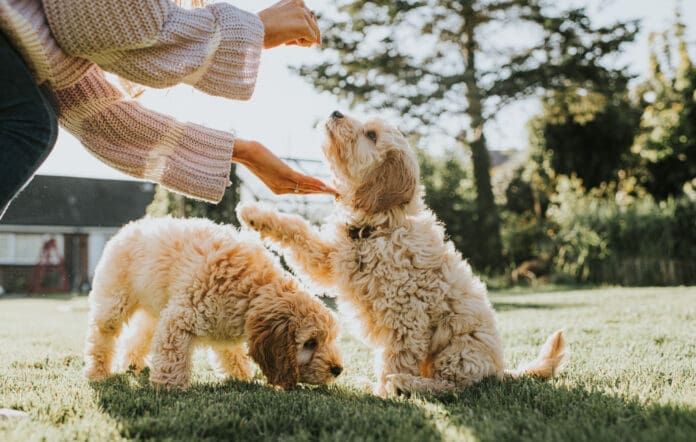“Littermate syndrome” is a general term used to describe what happens when things go wrong when trying to raise two puppies at once.
Puppies are a lot of work. Housetraining, frequent meals, teaching household manners and basic life skills, midnight pee breaks. It’s seemingly endless! These little guys are learning how to be real dogs and how they fit into our world, plus coping with the changes that come with growth and maturity. As the owner of a puppy, you are that puppy’s guide on this journey.
If you’re trying to raise more than one puppy at once, it’s easy to fall short on providing enough guidance. If each of the puppies isn’t getting all the attention, socialization, and training that they need, they can become dependent on a sibling and develop a wide variety of behavioral issues.
Littermate Syndrome Is Not a Disorder
Veterinary behaviorists do not recognize littermate syndrome as a disorder because it isn’t the presence of a littermate that causes the issues. Instead, these dogs’ behavioral problems are the result of insufficient socialization and enrichment. We can even see these problems in puppies who were raised by themselves and not given the support and training they need.
Puppies who don’t get proper socialization and training may show aggression, fear, separation anxiety, and lack of trust. None of these things are fun to deal with.
It is possible to raise two littermates—or two unrelated puppies that are the same age—at the same time and do it well. The key is to embrace each puppy as an individual and recognize that each one may have unique needs as they grow up.
Socialization
Socialization is the process of safely exposing your puppy to a wide range of people, places, and things so that she can be a confident adult dog.
Children are socialized by bringing them along to stores, parks, restaurants, and other people’s houses. We can do many of the same things with our puppies. Allow your puppy to observe the world and experience places and situations that will be part of her life.
It is critical that each puppy gets individual socialization outings, without their sibling. Each puppy may have different tolerance levels for new places and things, so you will need to adjust their experiences accordingly. During socialization, you want your puppy to always feel safe, so that she trusts that new things are usually fine and that you will never put her in a situation that she can’t handle. She needs to learn how to navigate the world on her own.
For example, some puppies might love greeting groups of people from the get-go. Other puppies might be more comfortable with one-on-one greetings with strangers at first. If one puppy is sensitive to loud noises, you will want to keep her farther away from things like construction zones so that she can take in the scary sounds at a distance where she is still relaxed.
Housetraining
Just because two puppies are littermates doesn’t mean that they will housetrain at the same rate. Remember that a large part of housetraining is us learning to read our puppy’s body language and understand when she is telling us that she needs to go outside. If you are raising two puppies, you will need to keep an eye on both and learn their individual signals.
Enrichment and Training
Both puppies need to learn things like sit, down, wait, coming when called, and to walk on a leash. You might be able to train both puppies at once sometimes, but it is usually best to give each puppy individual training time. This helps to foster your bond with each puppy and minimizes confusion as they learn new things.
It can be easier to teach puppies to walk nicely on a leash one at a time. If they are together, they are more likely to bounce and play, egging each other on and causing more pulling. Set a good foundation of leash manners individually, then practice group walks.
When doing play or enrichment activities with your puppies, be sure that each one is getting their fair share of fun and attention. Sometimes one puppy likes to hog the toys, or each puppy prefers different games. Foster each puppy’s unique preferences and have individual play sessions to improve your bond and learn more about each puppy’s personality.






